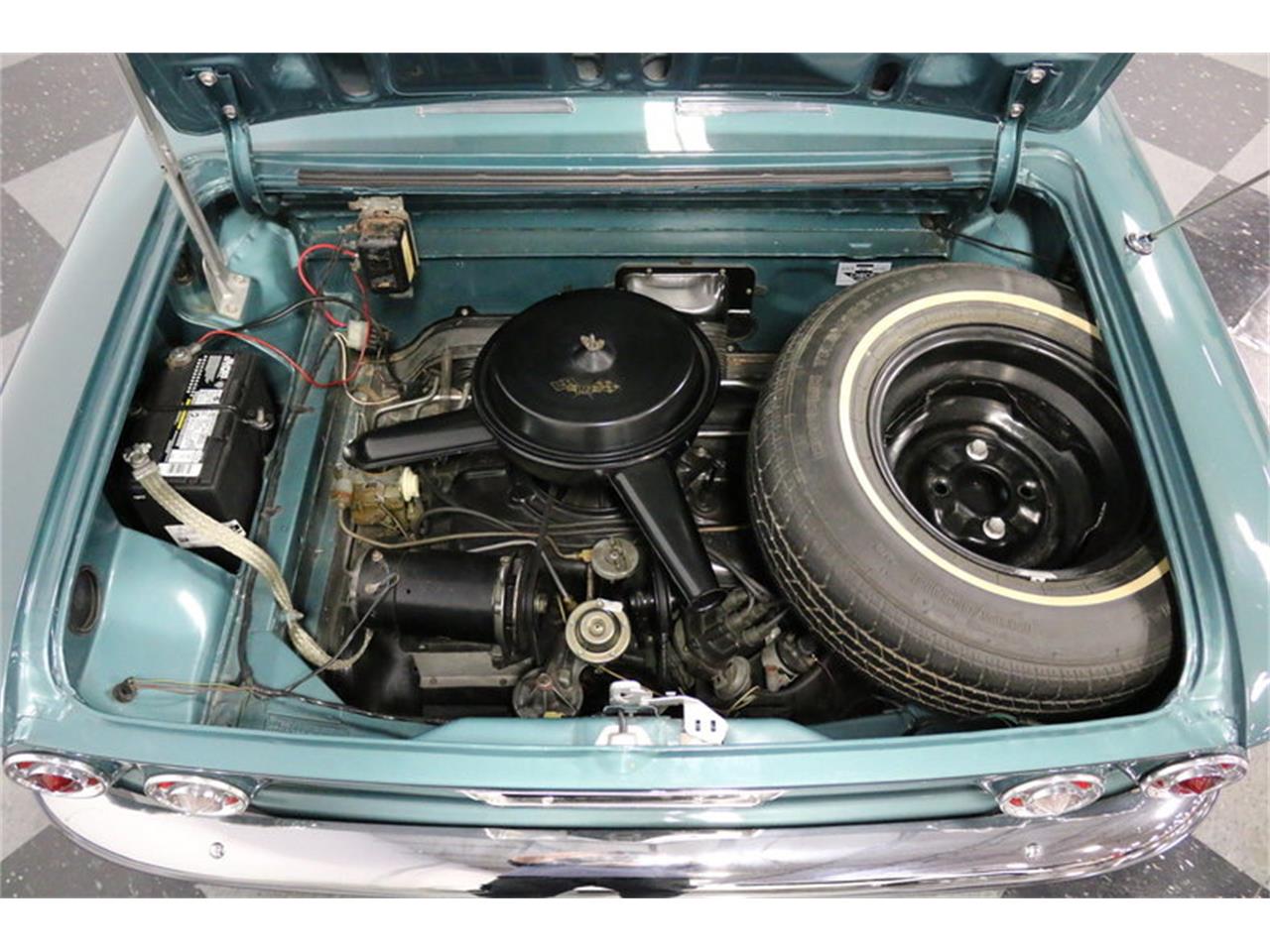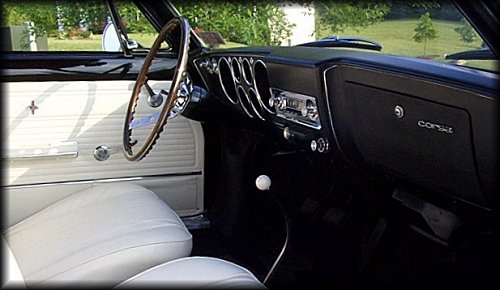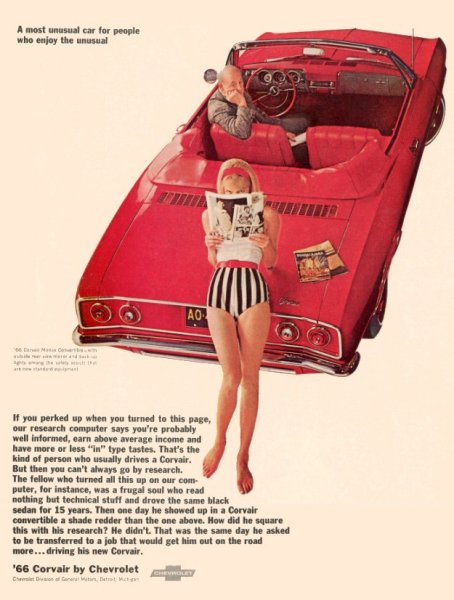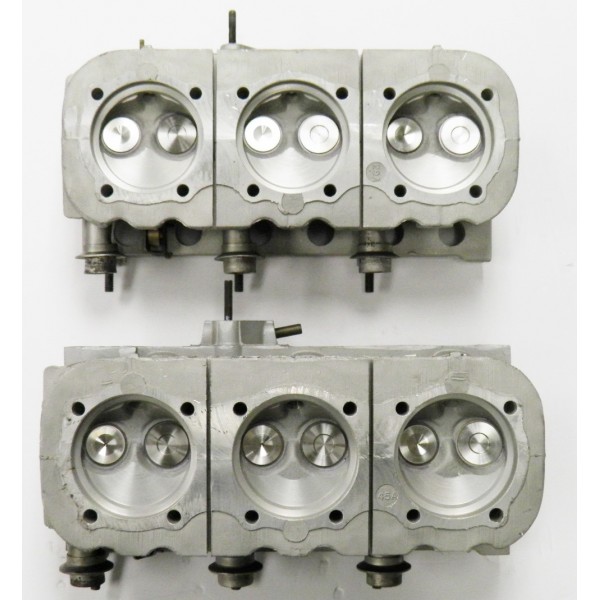Zorm here from the Florida pan handle, hoping to be a new owner soon. Mostly have dealt with early 70's ford trucks, 60's mustangs and any year full size Jeeps, Grand wag, J10, J20, Cherokee, those ones. Not really a Chevy guy, except or Corvairs.
Some history; I kinda got hooked on the 65 and up Corvairs when my dad brought one home from a junkyard. I grew up in Phoenix and one day, dad pulls up in a white 66/65? Corvair Monza with a blue interior. Leaked oil like crazy, and smoked. Mom was a little upset but dad said he got it from a junk yard he went to, to look for a part for the 71 F-250 we had, which I am now restoring.
Shortly after that, Dad lost the key. Well one Saturday afternoon, after chores, my brother and I were messing around in the car, we were both in high school at the time. That car amazed me, kinda simple yet intriguing. Well, I found a small screwdriver and stuck it in the ignition key hole twisted it and and she started right up, which scared the carp out of us two kids, we shut her down right away. Of course, Dad came out of the house and we both thought we were dead!. Dad came up, had a stern look but then asked us how did we start the car. My older brother said I did it, thinking I would get the discipline. I showed dad what I did, and after that, we spend the next maybe hour, going around the car, checking out the engine, under the hood, all around the interior, a good day in the end.
Heck, when mom and dad would go out of town, I would "steal" that car and go for a ride. Once, with my now wife, and dad's permission, the car died. I had a friend come and tow us, needless to say, not far, I put the chain around the track bar? anyway, it pulled the two front tires pointing into each other, yea, dad was not too happy but said it was up to me to fix it. So ended up finding a replacement part at junkyard that is now popular because of all the old cars, had a show for a little bit, "Desert Kings" and Roadkill got a Ford galaxy from that yard in an episode. First time I saw a turbo Corvair.
If ya got this far, thanks for hanging out. Anyway, Im am now in the market for a corvair. Like I mentioned, I am restoring the old family truck, heck in the family 47 years now. I am also working on an 83 Jeep Cherokee, in my family for the past 21 years. 4 door, last year of the big ones, slapping a Ford 351W in that girl. Brought it back from Sicily with us when we were stationed over there (retired Navy Corpsman)
So I'm looking for a 65-69 convertible, 140 engine (love the quad carbs) and needs to be a 4 speed. I found some that are over 12k, just a bit more than I would like to spend. If you all say, that may be the going price for what I am looking for, may need to rethink things.
In looking at Corvairs, what should I be looking for as far as body (normal rust areas) and mechanical (loose, leaking). What, once I do find a good car, would be the fist things to maybe replace or "refresh"
thanks folks!
FLA newbie
- terribleted
- Posts: 4584
- Joined: Sun Apr 18, 2010 2:36 pm
- Location: Atlanta, GA
- Contact:
Re: FLA newbie
The most important thing to look for particularly on a convertible is rust followed by rust followed by rust and then maybe evidence of major collision damage. mechanical stuff is easy and parts readily available but body cancer in a unibody car is bad news and hard to fix. Primary places to look are....but not limited to.....Rocker panels including inside and under the car, door hinge and striker posts, floors, and subframe sections under the floor. These areas are very structural and bad rot can make for a saggy car. The entire body is really somewhat structural so all repairs for rot should be done in steel. Other areas to look are everywhere, but base of the windshield, lower fenders and 1/4 panels, trunk floor, and bottom of front panel are prime areas for rot as well.
If the cars you are looking at for 12kish are solid (no significant rust...and you must look very closely to try to make sure the car has not been repaired cosmetically over bad rust...what i call smoke and mirrors), and pretty inside, outside, and under as well as run excellent I would say to extend your budget if possible and buy the best car you can get. Repair and restoration costs can quickly add up to costs far greater than getting a really nice car in the first place. Ideally you find the car that someone spent 500-1000hours and $15,000 or more in parts and materials restoring, for 12-20k somewhere. Let them take the loss. I have personally done quite a few restorations or Corvairs for myself and others that have cost $25-60K in restoration costs counting labor at a rate of $35/HR. None of these cars would sell for over the mid 20's and most would only bring somewhere in the teens. Now if you want a project Corvair to restore yourself and do it your way, then you will be upside down when you get done most likely, but, the key is find the most solid rust free body you can. Having replaced a number of rocker panels and rocker structure in a few Corvair convertibles (a very involved difficult repair), I would not even consider a Corvair convertible that has rocker rot period, whether it appears to be minimal or not.
If the cars you are looking at for 12kish are solid (no significant rust...and you must look very closely to try to make sure the car has not been repaired cosmetically over bad rust...what i call smoke and mirrors), and pretty inside, outside, and under as well as run excellent I would say to extend your budget if possible and buy the best car you can get. Repair and restoration costs can quickly add up to costs far greater than getting a really nice car in the first place. Ideally you find the car that someone spent 500-1000hours and $15,000 or more in parts and materials restoring, for 12-20k somewhere. Let them take the loss. I have personally done quite a few restorations or Corvairs for myself and others that have cost $25-60K in restoration costs counting labor at a rate of $35/HR. None of these cars would sell for over the mid 20's and most would only bring somewhere in the teens. Now if you want a project Corvair to restore yourself and do it your way, then you will be upside down when you get done most likely, but, the key is find the most solid rust free body you can. Having replaced a number of rocker panels and rocker structure in a few Corvair convertibles (a very involved difficult repair), I would not even consider a Corvair convertible that has rocker rot period, whether it appears to be minimal or not.
Corvair guy since 1982. I have personally restored at least 20 Vairs, many of them restored ground up.
Currently working full time repairing Corvairs and restoring old cars.
https://www.facebook.com/tedsautorestoration/
Located in Snellville, Georgia
Currently working full time repairing Corvairs and restoring old cars.
https://www.facebook.com/tedsautorestoration/
Located in Snellville, Georgia
- bbodie52
- Corvair of the Month

- Posts: 11908
- Joined: Mon Aug 06, 2012 12:33 pm
- Location: Lake Chatuge Hayesville, NC
- Contact:
Re: FLA newbie
Zorm wrote: » Sat Oct 10, 2020 9:31 am
Shortly after that, Dad lost the key. Well one Saturday afternoon, after chores, my brother and I were messing around in the car, we were both in high school at the time. That car amazed me, kinda simple yet intriguing. Well, I found a small screwdriver and stuck it in the ignition key hole twisted it and and she started right up, which scared the carp out of us two kids...
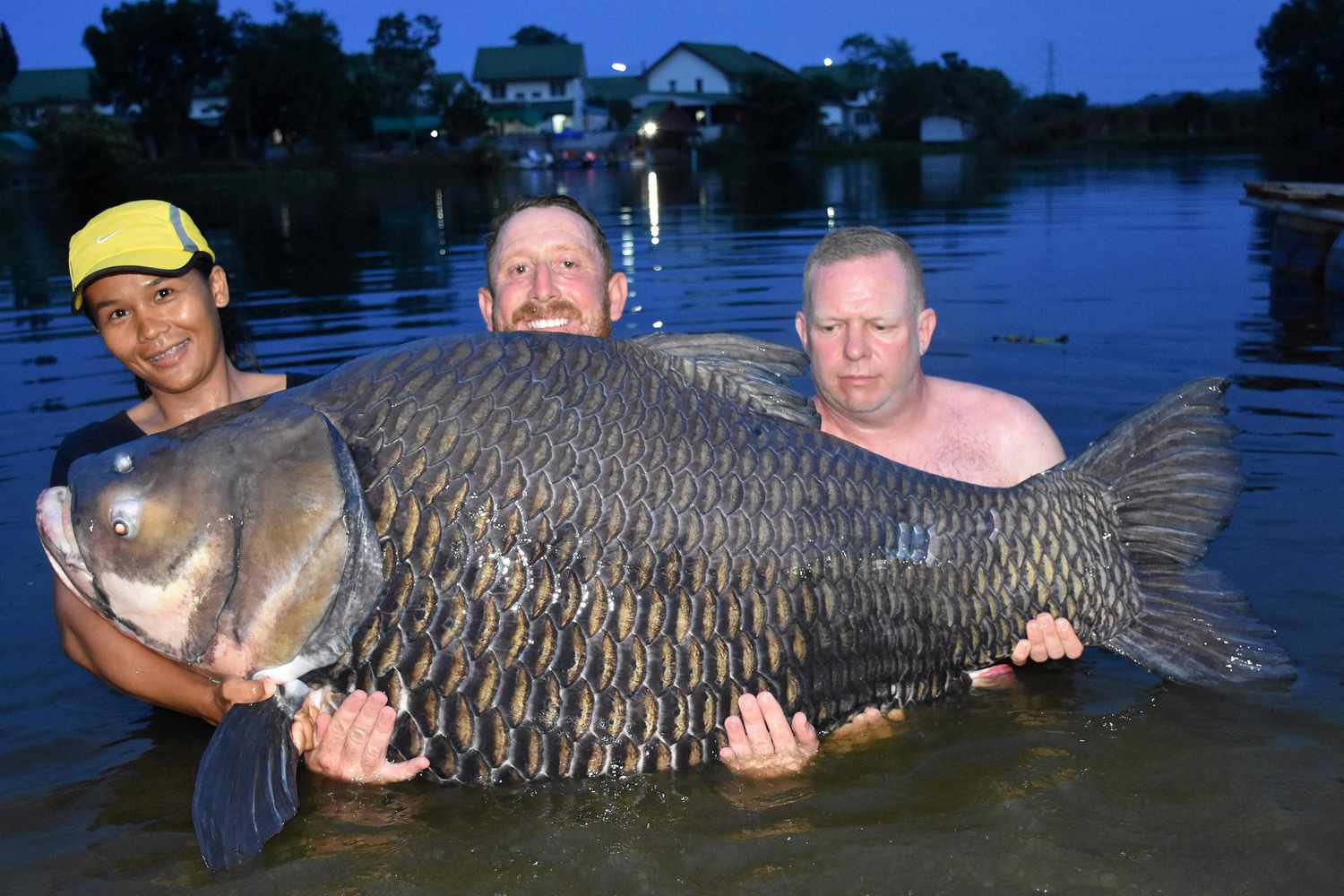

I love a good typo! And a good fish story!
Anyway...
If you are in for some more reading — here is a copy of some material that I wrote some time ago that may help to answer your questions...
Owning a classic 50+ year old Corvair could be a nightmare if you make a poor selection. Do you know how to work on classic cars or maintain them? Corvair-qualified mechanics are rare. What kind of budget do you have for this car? If you don't spend enough or select the car carefully, you are likely buying a project car that a hobbyist might purchase for a restoration project. Most Corvairs might be classified as temperamental. They are over 50 years old, and old technology. They require work to keep them on the road, and a maintenance budget. It is not like buying a modern new car.
If the owner/driver learns how to maintain the Corvair, reliability will increase. The possibility of a quick diagnosis as problems develop is also possible as knowledge increases. I have driven our Corvairs all over the USA, from coast to coast and in Germany while we were stationed there with the Air Force. One or more Corvairs have consistently been family transportation for most of my lifetime. There is no reason that a Corvair cannot be considered to be reliable transportation — if you make it that way. But it is not a modern new car with all of the latest technologies. It must be maintained and serviced regularly by an owner who appreciates, understands, and takes pride in its condition.
I would recommend reading through the following material, and then carefully consider your skills, abilities and needs. Owning a classic car takes a certain amount of pride in ownership that will give the owner/driver a sense of confidence in driving a classic car that reflects the certainty that comes from really knowing the car.
Please look over the following comments that I wrote some time ago, and see if they might help you with your plans to own a Corvair. You may have already seen these comments and suggestions, but if not, I hope they are helpful...
As a new prospective future owner of a Corvair, I will try to answer a few of your questions directly, and will also provide some material that I wrote in the past to others who were also considering purchasing their first Corvair. My family purchased our first Corvair in 1961 when I was eight years old. My parents bought a brand-new 1961 Corvair Monza four-speed manual transmission coupe. In 1965 they sold the first Corvair and purchased a new 1965 Corvair Corsa convertible (140 hp 4×1 carburetor engine with four-speed transmission). At age 66, it must be painfully obvious that I like these cars, since my wife and I continue to drive a 1966 Corvair Corsa convertible with the same engine and transmission that my parents had in their 1965 Corvair many decades ago.
I have driven Corvairs all over the United States and in Europe as well. During my 24 year career in the Air Force I took two Corvairs with me when we were transferred to an assignment near Ramstein Air Base, in Kaiserslautern, West Germany. These Corvairs easily transported my wife and two children along with me to assignments all over the United States. They were our primary transportation for most of the 24 years that I was in the Air Force. They also did quite well on the German autobahn during my three year assignment in Europe.
To give you some idea of my confidence in driving Corvairs, I purchased our current 1966 Corvair Corsa convertible from a classic car dealer in Lakeland Florida. My wife and I purchased this car in 2012 for our 40th wedding anniversary. I spotted the car on eBay and negotiated the purchase over the phone. Trusting that the car would have no problems with a return trip, I purchased a bus ticket from Atlanta to Lakeland Florida, completed the transaction, and drove the car 565 miles back to our home in North Carolina. The Corvair attracted a lot of attention at practically every gas stop and fast food restaurant that I stopped at on the return trip. I was also the recipient of many smiles and thumbs-up signs at intersections while I waited for the light to change! People seem to like Corvairs, and my new convertible always seemed to attract attention in the parking lot as a crowd of curiosity lookers would gather around the car while asking many questions and telling me stories about their memories of having a family Corvair in their younger days. I can't guarantee that you will always be able to drive a Corvair over long distances without mechanical problems. These Corvairs are more than 50 years old, after all. But if you take the time to learn to maintain your Corvair properly and develop the DIY skills needed to take care of your Corvair, you can probably count on some pretty good results.
I wrote the following material some years ago to answer similar questions from other potential new Corvair owners...
bbodie52 wrote:Thanks. I hope my previous comments were helpful. Your comments seem to reflect interest but also uncertainty. I have worked with a number of first-time Corvair buyers in Europe who were considering a purchase of a car from USA sources (to provide a greater range of cars to consider), while knowing that such a effort would make it impossible for them to test drive or personally evaluate the car before purchasing and shipping it. Your circumstances are somewhat similar. They contacted local experienced Corvair owners and aficionados through this Corvair Forum and through local CORSA clubs, and they often found sympathetic club members who were willing to help as local "third party" volunteer assistants.
There is much to consider, and the material below is something I wrote some years ago to try to help the first-time Corvair buyer. Corvairs can be found from sources throughout the United States and Canada. I hope you will find these comments to be useful...
The Corvairs are vintage 1960s technology and design — easy to learn and easy to maintain. I would say that learning to work on a Corvair is analogous to an experienced home DIY "shade tree" car mechanic learning to work on a motorcycle. The concepts and procedures are very similar, but the details and the way it is put together is a little different. With the Corvair engine (like a motorcycle) you are dealing with a lot of aluminum. The metal is soft when compared to steel and cast iron, so the use of a torque wrench, anti-seize compound and carefully avoiding cross-threading becomes more important. Also, (like some motorcycles) you are dealing with multiple carburetors so tuning procedures are a little different. The use of Corvair shop manuals and supplements, other technical guides, and information sources like the Corvair Forum, and perhaps joining a CORSA (Corvair Society of America) club chapter can help you to quickly learn about Corvairs. Information resources, like good Corvair parts suppliers, are plentiful if you know where to look. Suppliers like Clark's Corvair Parts have been well-respected and extremely supportive since 1973, and suppliers like that make Corvair ownership more practical and much-more possible. I taught myself how to remove a Corvair powertrain, overhaul the engine, and rebuild the Powerglide transmission during my summer vacation in 1969, when I was sixteen years old. I was working alone (my father had been transferred by Lockheed from northern California to southern California, and we had not yet moved to join him). I had a shop manual and a garage full of tools. There was no Internet, no Corvair Forum, no CORSA club — I was pretty-much on my own. Yet I learned and was successful (in 1972 that engine carried me and my new bride on our wedding day and on our honeymoon).
So you should be able to master working on Corvairs without too much trouble — except watch out for rust and body rot! The Corvair is of unibody construction, so most body repair involves cutting and welding. The doors, trunk lid (in the front), and engine compartment lid (in the back)
and maybe the gas filler door are the only bolt-on body components. Everything else is cut and weld, and the body serves as the main chassis frame. So unless you are a master body repair technician, you need to select your Corvair carefully and avoid excessive hidden rust or a "Bondo bucket". The door frame areas, fenders, floor pan, the bottom of the trunk, lower windshield and battery area often rust and rot.
What follows is an attempt at introducing new prospective Corvair Owners to Corvairs and some of the issues involved. Food for thought, before you take the plunge. This is a copy of something I wrote earlier, but I think it may be helpful in your quest for the "right" Corvair...
bbodie52 wrote:I will try to provide a quick summary of the 1960-1969 Corvair lineup, and will also try to provide some answers regarding the use of a Corvair as a "daily driver".
EARLY MODEL: 1960 - 1964 Corvairs were the first generation. Their body style emulated other Chevrolet body styles from the early 1960s. The rear suspension was a swing-axle design that was similar to the Volkswagen "Beetle". The 1960 model year was the only year with a 140 cubic inch engine, and there were some characteristics that were unique to that model year only. A number of refinements were implemented in the following year, including some restyling of the front end and an increase in displacement to 145 cubic inches (CI). A manual choke was used in 1961, and this was changed to an automatic choke design in 1962 that remained with the car through 1969. A turbocharged 150 hp Spyder was introduced in 1962, and the Spyder name remained with the turbocharged engine through 1964. In 1964 the engine displacement in all Corvair engines increased from 145 CI to 164 CI. There were also some suspension refinements, including a front anti-sway bar and a rear transverse leaf spring to improve handling in all 1964 Corvairs. Here are a few pictures of Early Model (EM) 1960-1964 Corvairs...
1963 Monza Coupe
1964 Monza Convertible
1962 Lakewood Station Wagon
1963 Monza Interior
1964 Corvair Engine Compartment
Corvair Rampside Truck
Corvair Greenbrier Van
Van/Truck Interior
LATE MODEL:The 1965 Corvair introduced a completely new body style, that was also seen later in similar styles in the Camaro and Pontiac Firebird. The drum brake size was increased, and the swing-axle rear suspension design used in EM Corvairs was abandoned. The new rear suspension was a design lifted from the Corvette Stingray.
1965 and 1966 Corvairs were nearly identical. In 1967-69 the top of the line Corsa was dropped, leaving the Monza and economy 500 until production was discontinued in the spring of 1969. During the 1967-69 production period, there were minor safety changes, such as a dual master brake cylinder in place of the single unit used in 1960-1966. Interior seats and trim changed somewhat, paralleling the items used in Camaros and some other GM products during that period.
All 1965-66 Corsas came with a standard 4-carburetor 140 hp engine, and an optional 180 hp turbocharged engine. The 140 hp engine remained optional in the rest of the lineup. Other engine options in the Monza and 500 were 110 hp and 95 hp dual carburetor engines. All engines could be had with a manual 4-speed or 3-speed transmission, or with a 2-speed Powerglide automatic (with the exception of the 1965-66 turbocharged 180 hp engine, which was available with the Corsa only, and only with a 4-speed manual transmission).
Air conditioning was a rare option, but can be found in the 1965-1967 lineup, and some of the EM Corvairs as well. The following link will provide you with some air conditioned Corvair background and history...
http://www.corvair.org/chapters/airvairs/
The brakes, front and rear suspension, transaxle and body were essentially identical in the Corsa, Monza, and 500. The primary differences in the cars were the instrument panel (the Corsa had more gauges), trim details, and the engine option.
The late model Corvairs were available in a 2-door Coupe, 2-door Convertible, and 4-door Sedan. In 1968, the four-door hardtop was discontinued, leaving three models—the 500 and Monza Hardtop Coupes and the Monza Convertible. Air conditioning was dropped as an option. The weight of the cars was very similar in all configurations.
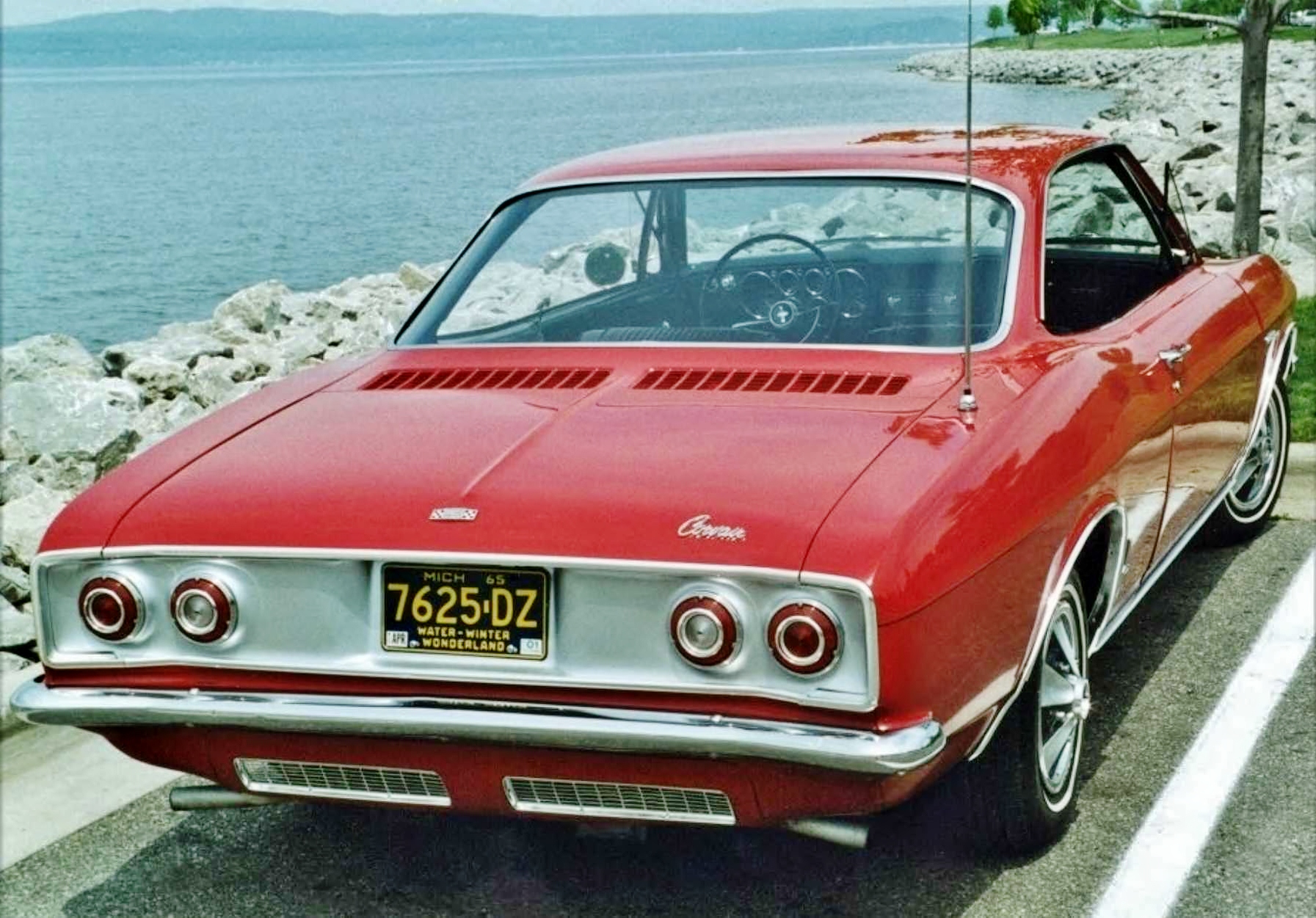
1965 Corvair Corsa Coupe

1965 Corvair Corsa Convertible

1965 Corvair Monza 4-Door Sedan
Corsa Interior (Top) / Monza Interior (Bottom)
140 hp 164 CI 4x1 Carburetor Engine (1965-1969)
Corvairs can suffer from rust and body rot problems, especially in areas that use a lot of road salt in the wintertime. While you may be able to learn and successfully attack most mechanical issues as a DIY effort, body decay can be much-more difficult, time-consuming, intimidating, and expensive to correct. So look for hidden rust or rot problems that may have been covered up with plastic filler, and be cautious in your Corvair selection.
A Corvair can serve well as a daily driver. But I would recommend a backup car or other alternatives, since ANY breakdown can put the car out of service for days until replacement parts can be obtained (if needed). If you have the skills and ability to work on the car yourself, repairs can often be completed fairly quickly. But if you have to rely on professional mechanics, downtime can be long and possibly expensive — if you can find a good mechanic to do the work for you.Corvairs can suffer from rust and body rot problems, especially in areas that use a lot of road salt in the wintertime. While you may be able to learn and successfully attack most mechanical issues as a DIY effort, body decay can be much-more difficult, time-consuming, intimidating, and expensive to correct. So look for hidden rust or rot problems that may have been covered up with plastic filler, and be cautious in your Corvair selection.bbodie52 wrote:Here is something I wrote over a year ago — Brad's Admonition, or some words of advice — based on over 50 years of exposure to Corvair ownership — that I wrote to try to give new Corvair buyers some idea of the issues involved. I'm sure you have some idea already, but I also think this is worth considering...
Since you are new to Corvairs, I want to give you some information that I have written to other new prospective first-time Corvair owners. I have been involved with Corvairs since I was eight years old, when my parents bought our first Corvair – a brand new 1961 Monza 2-door coupe, white on red with a 4-speed transmission. I now own Corvair number ten, which I purchased in June 2012. (If you want to read a brief personal biography that outlines my family background and our experiences with Corvairs, go to CORVAIR FORUM > Introductions > New from Lake Chatuge North Carolina. viewtopic.php?f=13&t=4032 ) I want to encourage your enthusiasm in developing your plans to buy your first Corvair, but at the same time I want to help you to think through just what you are getting into. So please read and consider these comments below...
I have listened to many potential Corvair first-time owners. Many have no prior experience with owning any classic car, and many have never driven a Corvair at all, or have not driven one in decades. Some are motivated by childhood memories of a family Corvair. They typically describe the desire to locate a perfect, restored, ultra-clean example, and look to the Corvair Forum Corvair enthusiasts and aficionados to tell them what to do.
The first thing I think that needs to be done is to try to set-aside the usual emotion-based enthusiasm that any car buyer might feel when visiting a dealer and gazing with emotional eagerness at the vast array of new cars displayed in the showroom, on the car lot, and in factory brochures and advertisements. There is an extreme difference between owning a 50+ year-old Chevrolet that was likely engineered, designed and built with pre-planned obsolescence in mind — a car that GM only envisioned having a life-span of ten years or so. Many of the potential Corvair buyers are captivated with the exciting idea of owning something different — something not normally seen on the road — something that your neighbor will not buy! Certainly that is the case with a Corvair, but owning a Corvair and enjoying that ownership demands a certain dose of reality before you "buy-in". Many are unprepared for the maintenance and upkeep demands of a Corvair. "Where can I find a good Corvair mechanic?" is a common question — often displaying an inability or unwillingness to do some mechanical work and maintain that car yourself. Yet qualified Corvair mechanics can be distant, expensive, inconvenient, and all-too rare. At a time when finding even a spark plug, fan belt, or oil filter for a Corvair often means an Internet or mail-order purchase, finding local support may be unlikely or impossible. Even searching automobile junk yards will often not help, because these cars are so rare and infrequently found that they have all but disappeared from the scrap yards too. Even locating and buying a used part is a mail-order proposition. And even if you spend $15,000-$20,000 for a fully-restored Corvair in mint condition, it still comes "as-is", with no warranty and little in the way of a local support system — far different than what most car buyers are used to expecting! These are the realities of owning an older classic car.
Corvairs are popular and affordable classic cars, and enjoy a good infrastructure of maintenance supporters, owner's clubs, and parts suppliers — and that REALLY helps! But I suspect that most happy Corvair owners are something of "shade-tree mechanics" and hobbyists who are prepared to deal with the risks and problems related to Corvair ownership. It requires a long-term commitment and a dose of reality to happily own a classic Corvair. The "first date" infatuation with the attractiveness and uniqueness of a Corvair will not sustain you in a long-term relationship with a Corvair. It is far-better to have a realistic idea of just what you are getting into before you "take the plunge" and buy your dream car.
A cautious, knowledgeable and educated search for your dream Corvair is a great start, and a careful and realistic analysis of your own mechanical talents, skills and abilities is also useful. If you plan to have a mechanic do most of the work for you, the availability of a Corvair-skilled mechanic and the associated costs involved must be taken into account in your financial planning to own a Corvair.
I try to not be too negative, but I have worked with others who came to realize that Corvair ownership was more than they could handle. I just feel that new prospective Corvair owners come here to this forum to learn from others who have more experience, and we are not doing them any favors by "candy coating" the issues involved. If they pass the "sanity check" and still want to pursue buying a Corvair, then GREAT! This Forum and perhaps some local Corvair club members can potentially help them pursue that dream. But it should be a realistic dream, and not a frustrating "nightmare" experience. Better to make a clear-headed, informed decision early in the game!
I hope that these comments are useful to you. I know I get "long-winded", but I also know you are trying to make an important decision, and I hope all of these comments will help you.
A Corvair can serve well as a daily driver. But I would recommend a backup car or other alternatives, since ANY breakdown can put the car out of service for days until replacement parts can be obtained (if needed). If you have the skills and ability to work on the car yourself, repairs can often be completed fairly quickly. But if you have to rely on professional mechanics, downtime can be long and possibly expensive — if you can find a good mechanic to do the work for you.
This will give you some idea of the differences between the 140 hp engine and the 110 hp engine.
140 hp vs. 110 hp...
140 hp Heads...
- Same high-performance camshaft on both 140 hp and 110 hp engines. Low performance camshaft in the 95 hp engine.
- Same 164 Cubic Inch displacement with same bore and stroke on all 1964-1969 engines.
- Stronger, nitrided crankshaft on the 140 hp and 180 hp turbocharged engines. (Nitriding is a heat treating process that diffuses nitrogen into the surface of a metal to create a case-hardened surface).
- On the 140 hp engine, a 4x1 carburetor arrangement, with two primary and 2 secondary 1-barrel carburetors, connected with a progressive linkage to open the secondary carburetors as you approach full throttle. (Equivalent to a 4 barrel carburetor on the 140 hp engine, vs. a 2 barrel carburetor (2x1) on the 110 hp and 95 hp engine).
- Dual muffler, dual exhaust with larger exhaust ports and larger exhaust manifolds on the 140 hp engine. Single exhaust on the 110 hp and 95 hp engine.
- 9.0:1 Compression Ratio in both 140 hp and 110 hp engines. 8.0:1 CR on the 95 hp engine.
It's all about better breathing at full throttle at the high RPM ranges. At lower RPM the big valves and dual exhaust don't make much difference, and the secondary carburetors are not open for business.
110 hp Heads...
What are the final two letters on your engine serial number (see sample below for location)?
Here are several Corvair For Sale websites that may be useful...
eBay is one possibility. There are several specialized used car dealers who focus on finding and selling classic cars. Many are in very good condition. You pay a little more for this "finder's fee", but many of these dealers focus on classic car enthusiasts and the dealers value their reputations. In fact, my current 1966 Corsa convertible was initially spotted on eBay, and I bought it from a Florida classic car dealer in Lakeland, Florida. I took a Greyhound bus from Atlanta, closed the deal in Florida, and drove the car home (571 miles) without any problem in 2012. As with all classic Corvairs, the buyer must be cautious. Sometimes CORSA club members or Corvair Forum members will assist potential buyers by acting as a "third party" to examine local Corvairs that were initially located on eBay. Several Corvair buyers in England and Italy bought their Corvairs in this way with the assistance of Corvair enthusiasts in the USA who helped them (since there was no practical way for the prospective buyer to personally examine the Corvairs before closing the deal and shipping the cars to Europe).
CORVAIRS FOR SALE
http://www.corvair.com/user-cgi/pages.c ... =buyorsell
Just Listed!
https://www.corvair.org/go-shopping
Chevrolet Corvair for Sale
http://www.hemmings.com/classifieds/car ... et/corvair
Classifieds for Classic Chevrolet Corvair
http://classiccars.com/listings/find/al ... et/corvair
http://www.oldride.com/classic_cars/che ... rvair.html
Corvairs for Sale
https://www.facebook.com/pages/Corvairs ... 7975069947
Even a
for "Corvairs for Sale" will produce many leads.
http://www.shadesclassiccars.com/
Used car dealer in Hastings, Nebraska. Specializes in Corvairs.
Address: 1016 S Burlington Ave, Hastings, NE 68901
Phone: (402) 463-5577
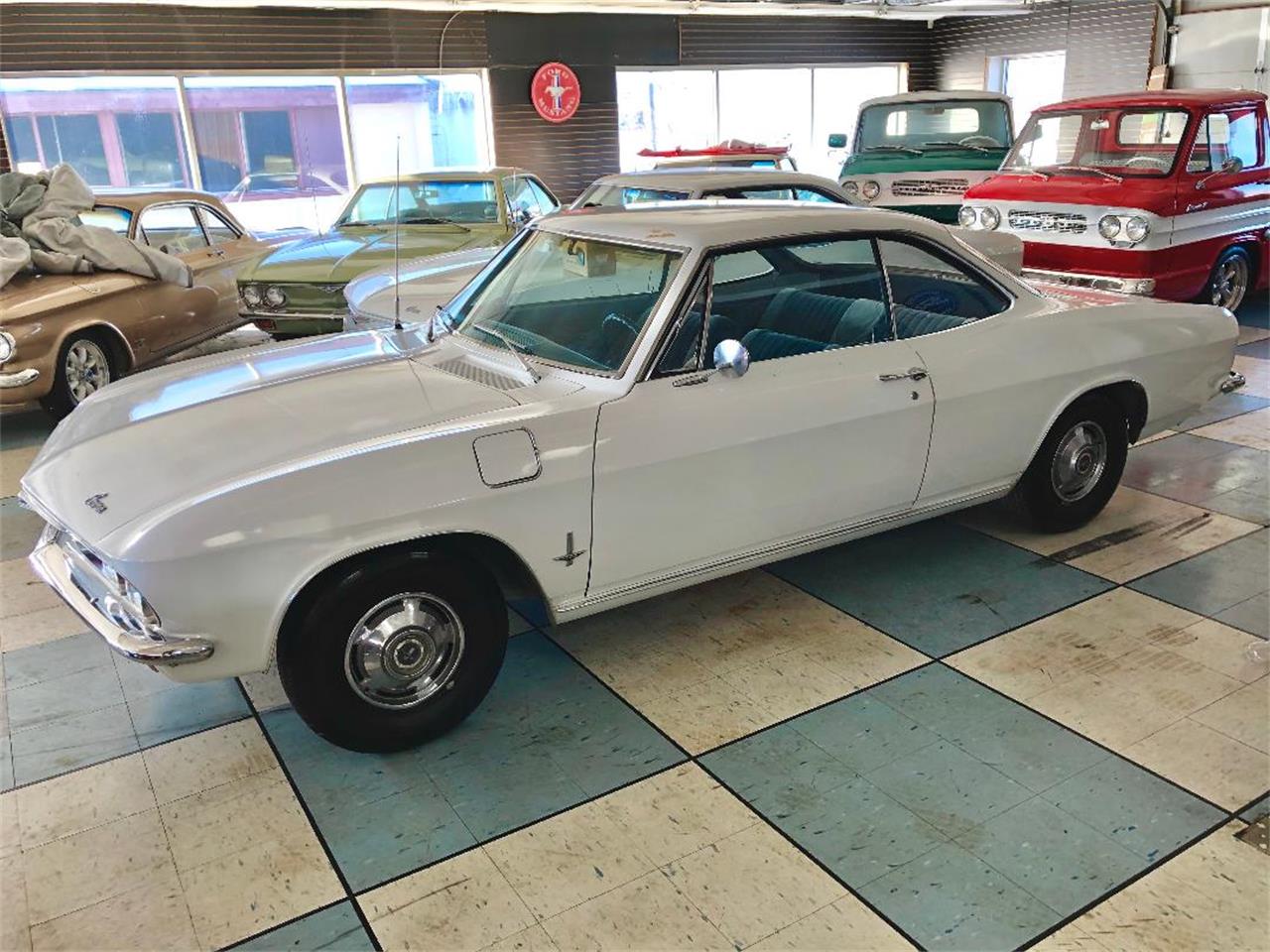
Don't get trapped in a "fixer upper" that can be a real money pit! Shop around, and run any car you are seriously considering by the Corvair Forum for some suggestions and opinions. Buy the cleanest car you can afford, rather than getting trapped in an endless project vehicle. Pay particular attention to the condition of the body, as a rusty Corvair that is suffering from body rot can be a depressing disaster. To paraphrase Jay Leno, you can buy a project car and spend $50000 to restore it, so that you can own a $15000 Corvair! The difference between a 140 hp 4x1 carburetor 4-speed Corvair Corsa and a Corvair Monza with the same powertrain is the instrument panel and a little difference in the trim. The weight of the car, the suspension, the brakes, the powertrain, etc. is all the same!
If there is a CORSA (Corvair Society of America) club chapter near you, check them out. Their experienced Corvair owners can be invaluable in advising you and helping you to find the right Corvair for you, at the right price!

Brad Bodie
Lake Chatuge, North Carolina
 1966 Corvair Corsa Convertible
1966 Corvair Corsa Convertible
Lake Chatuge, North Carolina
 1966 Corvair Corsa Convertible
1966 Corvair Corsa ConvertibleRe: FLA newbie
Rob
- Cornucopia of Corvairs
Ocklawaha FL
- Cornucopia of Corvairs
Ocklawaha FL
Re: FLA newbie
Also, Chris Shade @ Shade’s Classic Cars always has lot of nice cars. Here is a nice ‘65 140/4spd “Corsa Clone” he has in stock. Looks to be right in your budget zone... :)
Rob
Rob
Rob
- Cornucopia of Corvairs
Ocklawaha FL
- Cornucopia of Corvairs
Ocklawaha FL
